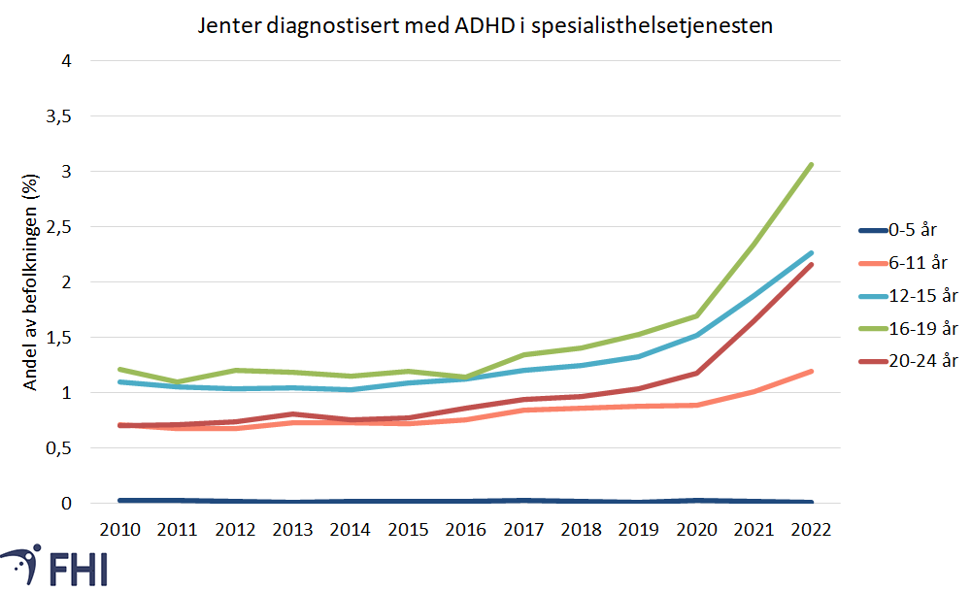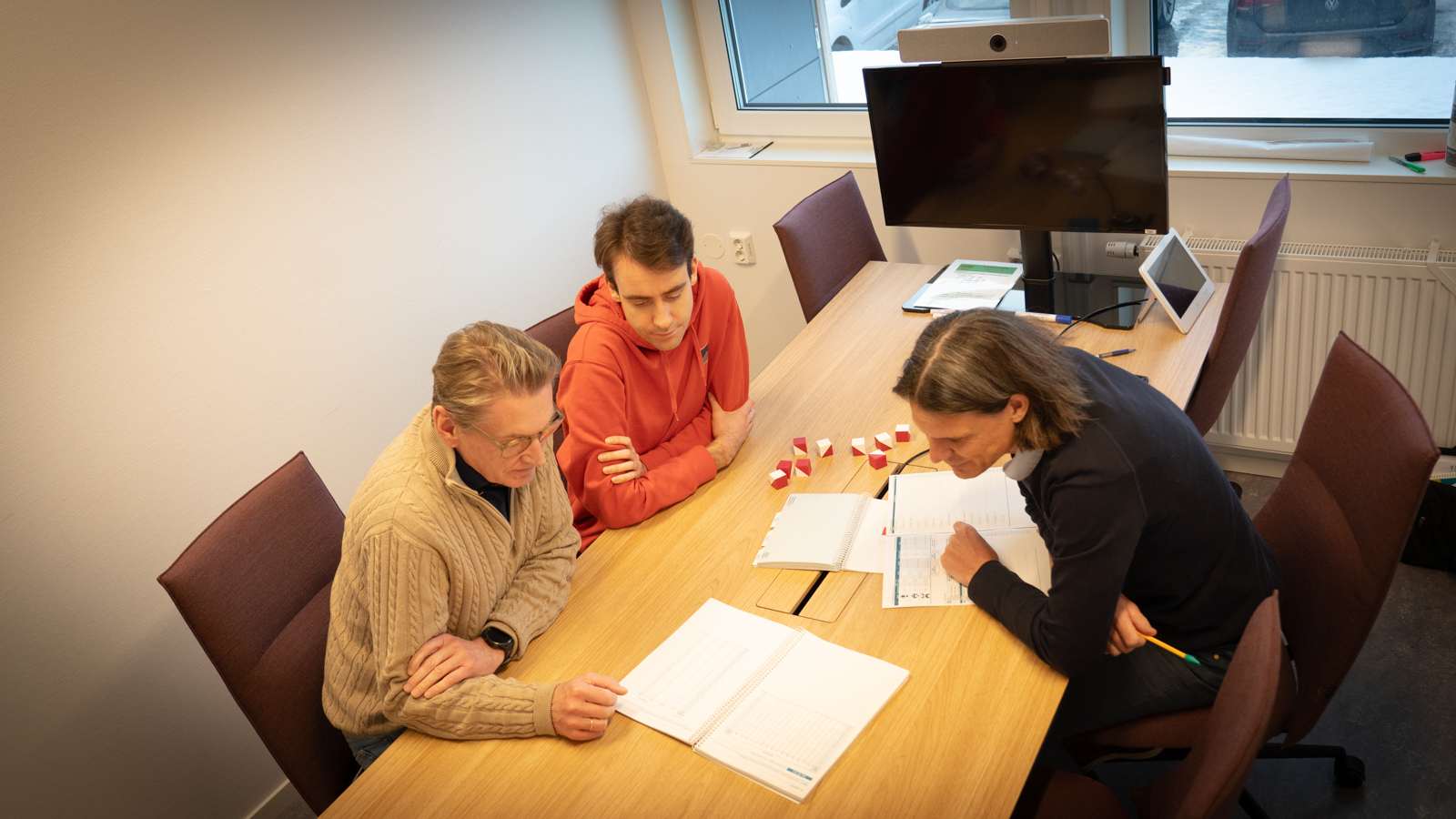Researchers followed children diagnosed with ADHD and Asperger's over ten years to see how their lives developed. The results show that many manage well.

When he was ten years old, he wrecked the apartment at home. He smashed the TV and the stereo. Almost daily, he had violent outbursts of rage. He had trouble at school, did not make friends and wore out those at home.

He received several diagnoses: ADHD, Tourette's, Pervasive Developmental Disorder, and eventually autism.

Between two and three percent of Norwegian children and adolescents have an ADHD diagnosis. For autism, including childhood autism and Asperger's syndrome, the figure is just under one percent. There is an increase in all diagnoses across all ages and for both genders. The graph shows the development of ADHD diagnoses for girls in recent years.
But: what do we know about how they are doing when they grow up? Are they destined for a life of substance abuse and crime?
They are not.
In the LINEUP study – Lillehammer Neurodevelopmental Follow-up Study – researchers at Innlandet Hopital and INN University have followed the same children from the age of 12 to their twenties.
The results? There is hope! More on that later.

It was a difficult time. I struggled socially and was often angry and frustrated. It was probably very challenging for my parents and siblings as well as my teachers.
--oppe-gang.jpg)
He started developing tics when he was in second grade. Facial grimaces and other involuntary movements. At school and at home, he was restless and often angry. One time it got so bad that his class had to evacuate the classroom.
He was acutely placed in a child welfare institution after wrecking the entire apartment at home. Following extensive evaluation, he received a definitive diagnosis — autism.
Six months later, he moved back home from the institution. Then began the targeted effort to help the boy function in everyday life — at school, at home and in interactions with other people.
With a definitive diagnosis, it became easier for my surroundings to understand. It got better gradually, but at times it was one step forward, two steps back.
He struggled a lot with anxiety, especially related to understanding other people and interpreting facial expressions. He had to learn to recognise emotions in himself and others.
He says his parents were supportive, and the school began to accommodate in a different way than before.
Academically, he fell behind, but in secondary school he began to take an interest in at least some subjects.
In upper secondary school, he worked hard to make up for lost time. It went well. Very well. He graduated with top marks in many subjects and an average score above 5.

He went straight on to university studies — in psychology.
Throughout the studies, I became more and more interested in my own diagnosis. My own difficulties made me want to understand people better.
He breezed through his bachelor's and master's and went straight into a PhD. In December 2023 he defended his thesis, completing it in less than the standard time.

The troublemaker Stian Orm had become a doctor at the age of just 27 years.
His PhD focuses on young adults with ADHD and how cognitive function and additional mental health challenges during childhood and adolescence impact later well-being, functioning and mental health.

Now, he is an associate professor at INN University, teaching psychology students.
Certainly, none of those around me when I was a young boy could have imagined that I would become an associate professor and earn a doctorate at 27 years old.
Stian Orm

His research is part of the LINEUP study, the Lillehammer Neurodevelopmental Follow-up Study.
Here is Stian Orm together with his research colleagues Professor Per Normann Andersen and associate professor and project leader Erik Winther Skogli.
The study has been ongoing since 2009, and the researchers have followed the same children over a decade. They have gained unique insights by tracking children with ADHD, autism and Tourette syndrome over such a long period.
The researchers have found that many who are diagnosed with ADHD at the age of 12, no longer meet the criteria for an ADHD diagnosis by the time they are 22.
In fact, six out of ten have such mild symptoms that they can be said to no longer have the diagnosis.
Among those with autism spectrum disorders, including Asperger's, there is a similar trend:
Approximately 35 percent report such mild symptoms after 10 years that they no longer meet the criteria for an autism diagnosis.

The children involved in the study were also tested for their cognitive functions, or simply put, how well their brain machinery performs.
They were asked to recall number series, hold multiple rules in thir mind simultaneously and solve tasks in various ways to assess concentration, working memory and ability to follow through tasks.

And the researchers also measure additional problems or comorbidities — problems that arise in extention of the diagnosis itself.
Anxiety and depression are much more prevalent among those with ADHD and autism than others, and the study shows that these comorbidities can be a bigger issue than the diagnosis itself.
Although ADHD and autism symptoms decrease and children's cognitive function improves from age 12 to 22, results from the LINEUP study also demonstrate the following:
-
The cognitive difficulties persist compared to normally functioning children and continue into adulthood. Although the symptoms have become milder, children with ADHD and autism do not catch up to bridge the cognitive developmental gap as they grow older. This affects their ability to manage school and work.
-
The greater the cognitive difficulties participants experience as children, the more they struggle with additional problems or comorbidities such as anxiety and depression in adulthood.
-
The more mental health struggles the participants experience during childhood and adolescence, the worse quality of life they have as adults.

Stian also struggled with comorbidities. He received treatment for his anxiety issues.
I received good help, and I think more and more about what my life would have looked like without this treatment. How much would anxiety have hindered my development and Learning?
The associate professor at INN University believes that the research findings should have consequences for how we evaluate treatment:
Is it appropriate to focus so much on alleviating symptoms with medication as we do today? Is it equally important to treat anxiety and depression and facilitate coping strategies in school and daily life?
And: are we providing enough practical support to adults who struggle to complete their education, maintain employment or manage their finances?

Stian and the other researchers at Innlandet Hospital and INN University are now continuing the study.
They hope to follow up the same participants after another ten years, when they are 32 years old, to see how they are doing then.

For Stian Orm, life as a researcher is closely intertwined with his own life:
I bring my history and background into the research, and I personally relate to what the study participants share.
At the same time, I find that our research findings shed new light on my own experiences. I think a lot about how things could have turned out if I had not received the right support and treatment.
Ask:
- stian.orm@inn.no
- Phone
- +47 61 28 84 45
- erik.skogli@inn.no
- Phone
- +47 61 28 75 19
Made by:
- erlend.moe@inn.no
- Phone
- +47 61 28 80 28
- lars.mythen@inn.no
- Phone
- +47 61 28 74 66
- nan.kolby@inn.no
- Phone
- +47 62 43 03 26
Facts about LINEUP:
-
The Lillehammer Neurodevelopmental Follow-Up Study (LINEUP) is a research project funded and conducted by researchers at Innlandet Hospital in collaboration with researchers from INN University.
-
The goal of the long-term study is to assess cognitive skills, mental health, daily functioning and quality of life among young adults who had ADHD, autism spectrum disorder or Tourette syndrome as children.
-
The study builds upon the project 'Emosjonell og kognitiv utvikling hos barn og ungdom med nevropsykriatriske lidelser', led by Professor Merete Glenne Øie at the University of Oslo and Innlandet Hospital from 2009 to 2015.
-
181 children and adolescents were evaluated in the research project. The same children were assessed two years later and as part of the follow-up study ten years later.
-
So far, the projects have resulted in around 30 published research articles.
Read more:
- Fossum, I. N., Orm, S., Andersen, P. N., Geurts, H. M., Øie, M. G., & Skogli, E. W. (2023). Childhood Executive Function Predicts Internalizing and Externalizing Symptoms in Emerging Adults With and Without Autism: A 10-Year Longitudinal Study. Developmental neuropsychology, 1-15.
- Andersen, P. N., Orm, S., Fossum, I. N., Øie, M. G., & Skogli, E. W. (2023). Adolescence internalizing problems as a mediator between autism diagnosis in childhood and quality of life in emerging adults with and without autism: a 10-year longitudinal study. BMC Psychiatry, 23(1), 149.
- Orm, S., Andersen, P. N., Fossum, I. N., Øie, M. G., & Skogli, E. W. (2022a). Brief report: Autism spectrum disorder diagnostic persistence in a 10-year longitudinal study. Research in Autism Spectrum Disorders, 97, 102007.
- Orm, S., Andersen, P. N., Teicher, M. H., Fossum, I. N., Øie, M. G., & Skogli, E. W. (2022b). Childhood executive functions and ADHD symptoms predict psychopathology symptoms in emerging adults with and without ADHD: A 10-year longitudinal study. Research on Child and Adolescent Psychopathology.
- Fossum, I. N., Andersen, P. N., Oie, M. G., & Skogli, E. W. (2021). Development of executive functioning from childhood to young adulthood in autism spectrum disorder and attention-deficit/hyperactivity disorder: A 10-year longitudinal study. Neuropsychology.
- Orm, S., Øie, M. G., Fossum, I. N., Andersen, P. N., & Skogli, E. W. (2021). Declining Trajectories of Co-occurring Psychopathology Symptoms in Attention-Deficit/Hyperactivity Disorder and Autism Spectrum Disorder: A 10-Year Longitudinal Study. Frontiers in Psychiatry, 12(1774).


